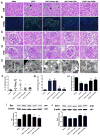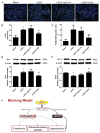Excess LIGHT contributes to placental impairment, increased secretion of vasoactive factors, hypertension, and proteinuria in preeclampsia
- PMID: 24324043
- PMCID: PMC4053533
- DOI: 10.1161/HYPERTENSIONAHA.113.02458
Excess LIGHT contributes to placental impairment, increased secretion of vasoactive factors, hypertension, and proteinuria in preeclampsia
Abstract
Preeclampsia, a prevalent hypertensive disorder of pregnancy, is believed to be secondary to uteroplacental ischemia. Accumulating evidence indicates that hypoxia-independent mediators, including inflammatory cytokines and growth factors, are associated with preeclampsia, but it is unclear whether these signals directly contribute to placental damage and disease development in vivo. We report that LIGHT, a novel tumor necrosis factor superfamily member, is significantly elevated in the circulation and placentas of preeclamptic women compared with normotensive pregnant women. Injection of LIGHT into pregnant mice induced placental apoptosis, small fetuses, and key features of preeclampsia, hypertension and proteinuria. Mechanistically, using neutralizing antibodies specific for LIGHT receptors, we found that LIGHT receptors herpes virus entry mediator and lymphotoxin β receptor are required for LIGHT-induced placental impairment, small fetuses, and preeclampsia features in pregnant mice. Accordingly, we further revealed that LIGHT functions through these 2 receptors to induce secretion of soluble fms-like tyrosine kinase-1 and endothelin-1, 2 well-accepted pathogenic factors in preeclampsia, and thereby plays an important role in hypertension and proteinuria in pregnant mice. Lastly, we extended our animal findings to human studies and demonstrated that activation of LIGHT receptors resulted in increased apoptosis and elevation of soluble fms-like tyrosine kinase-1 secretion in human placental villous explants. Overall, our human and mouse studies show that LIGHT signaling is a previously unrecognized pathway responsible for placental apoptosis, elevated secretion of vasoactive factors, and subsequent maternal features of preeclampsia, and reveal new therapeutic opportunities for the management of the disease.
Keywords: endothelin-1; herpes virus entry mediator; lymphotoxin-beta receptor; preeclampsia; receptors, tumor necrosis factor, member 14; tumor necrosis factor ligand superfamily member 14.
Figures




Similar articles
-
Hypoxia-independent upregulation of placental hypoxia inducible factor-1α gene expression contributes to the pathogenesis of preeclampsia.Hypertension. 2015 Jun;65(6):1307-15. doi: 10.1161/HYPERTENSIONAHA.115.05314. Epub 2015 Apr 6. Hypertension. 2015. PMID: 25847948 Free PMC article.
-
Autoantibody-mediated complement C3a receptor activation contributes to the pathogenesis of preeclampsia.Hypertension. 2012 Sep;60(3):712-21. doi: 10.1161/HYPERTENSIONAHA.112.191817. Epub 2012 Aug 6. Hypertension. 2012. PMID: 22868393 Free PMC article.
-
Metformin as a prevention and treatment for preeclampsia: effects on soluble fms-like tyrosine kinase 1 and soluble endoglin secretion and endothelial dysfunction.Am J Obstet Gynecol. 2016 Mar;214(3):356.e1-356.e15. doi: 10.1016/j.ajog.2015.12.019. Epub 2015 Dec 22. Am J Obstet Gynecol. 2016. PMID: 26721779
-
Pregnancy-specific expression of protease-activated receptor 1: a therapeutic target for prevention and treatment of preeclampsia?Am J Obstet Gynecol. 2022 Feb;226(2S):S945-S953. doi: 10.1016/j.ajog.2021.11.1367. Am J Obstet Gynecol. 2022. PMID: 35177224 Free PMC article. Review.
-
Bioactive factors in uteroplacental and systemic circulation link placental ischemia to generalized vascular dysfunction in hypertensive pregnancy and preeclampsia.Biochem Pharmacol. 2015 Jun 15;95(4):211-26. doi: 10.1016/j.bcp.2015.04.012. Epub 2015 Apr 24. Biochem Pharmacol. 2015. PMID: 25916268 Free PMC article. Review.
Cited by
-
The Influence of Hypertensive Therapies on Circulating Factors: Clinical Implications for SCFAs, FGF21, TNFSF14 and TNF-α.J Clin Med. 2020 Aug 26;9(9):2764. doi: 10.3390/jcm9092764. J Clin Med. 2020. PMID: 32858953 Free PMC article.
-
Elevated Endothelial Hypoxia-Inducible Factor-1α Contributes to Glomerular Injury and Promotes Hypertensive Chronic Kidney Disease.Hypertension. 2015 Jul;66(1):75-84. doi: 10.1161/HYPERTENSIONAHA.115.05578. Epub 2015 May 18. Hypertension. 2015. PMID: 25987665 Free PMC article.
-
Matrix Metalloproteinases in Normal Pregnancy and Preeclampsia.Prog Mol Biol Transl Sci. 2017;148:87-165. doi: 10.1016/bs.pmbts.2017.04.001. Epub 2017 May 22. Prog Mol Biol Transl Sci. 2017. PMID: 28662830 Free PMC article. Review.
-
Soluble Forms of Immune Checkpoints and Their Ligands as Potential Biomarkers in the Diagnosis of Recurrent Pregnancy Loss-A Preliminary Study.Int J Mol Sci. 2023 Dec 29;25(1):499. doi: 10.3390/ijms25010499. Int J Mol Sci. 2023. PMID: 38203670 Free PMC article.
-
Molecular determinants of microvascular dysfunction in hypertensive pregnancy and preeclampsia.Microcirculation. 2018 Oct 19:e12508. doi: 10.1111/micc.12508. Online ahead of print. Microcirculation. 2018. PMID: 30338879 Free PMC article.
References
-
- Roberts JM, Cooper DW. Pathogenesis and genetics of pre-eclampsia. Lancet. 2001;357:53–56. - PubMed
-
- Granger JP, Alexander BT, Llinas MT, Bennett WA, Khalil RA. Pathophysiology of preeclampsia: Linking placental ischemia/hypoxia with microvascular dysfunction. Microcirculation. 2002;9:147–160. - PubMed
-
- Godfrey KM, Barker DJ. Fetal nutrition and adult disease. The American journal of clinical nutrition. 2000;71:1344S–1352S. - PubMed
-
- Barker DJ. In utero programming of chronic disease. Clin Sci (Lond) 1998;95:115–128. - PubMed
-
- Saito S, Sakai M. Th1/th2 balance in preeclampsia. Journal of reproductive immunology. 2003;59:161–173. - PubMed
Publication types
MeSH terms
Substances
Grants and funding
LinkOut - more resources
Full Text Sources
Other Literature Sources
Miscellaneous

